2. Magnetic Direction Conversion
a. Magnetic Meridian
Directions and angles for early land surveys were measured using a compass which is referenced to magnetic north. Unlike many other meridians, magnetic north is relatively easy to establish in the field: just hold a compass level and wait patiently. When it stops swinging, the needle will be aligned with the magnetic north-south meridian, Figure C-2.
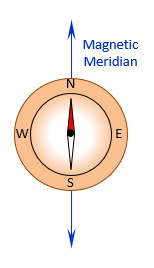 |
| Figure C-2 Compass and Meridian |
While easy to establish, there are two major problems using magnetic directions:
(1) Poles move
The magnetic poles move over time which affects the median direction. Figure C-3 is from NOAA National Centers for Environmental Information (https://maps.ngdc.noaa.gov/viewers/historical_declination/). It shows the magnetic north pole movement from 1590 to 2025 based on measurements and models.
The movement is neither systematic nor constant which means magnetic directions of lines change inconsistently over time.
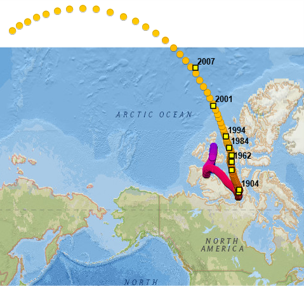 |
| Figure C-3 Magnetic North, 1590-2025 (from NOAA NCEI) |
(2) A magnetic meridian is not straight
Natural anomalies along the meridian affect the magnetic field causing it to change direction. Local anomalies, such as high voltage power lines and large buildings with steel superstructures, will attract the compass needle. Natural anomalies change over time and humans are constantly building stuff so the resultant meridian is neither stable over time nor mathematical.
Local anomalies can be especially problematic. The magnetic meridians at both ends of a long line may not be parallel if there is a significant local anomaly at one end. Forward and back directions may differ from simple bearing quadrant reversal and 180° azimuth difference.
Because of these issues, magnetic directions are not typically used today. But because they have been used in the past, a surveyor should understand how to convert magnetic directions to a static reference meridian.
b. Declination
Magnetic directions are generally converted to true directions. Declination, Figure C-4, is the angle from the true meridian to the magnetic median.
 |
| Figure C-4 Declination |
It is expressed as an angle and direction. The declination in Figure C-5(a) is 3°00' E, in Figure C-5(b) is 4°30'W.
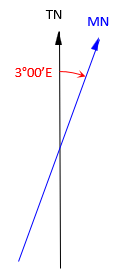 |
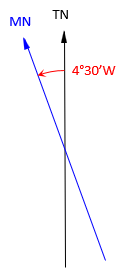 |
| (a) East | (b) West |
| Figure C-5 Declination: Angle and Direction |
|
Because magnetic north moves over time, declination changes. Variation is the rate of declination change. It is not constant over time, Figure C-6.
 |
| Figure C-6 Declination and Variation |
Future variation can only be predicted from models based on past behavior. Variation is an annual rate stated as an angle and direction. For example, a 1°00' E variation means that in one year declination moves east 1°00'.
Isogonic lines are used to graphically depict declination behavior over an area. An isogonic line is a line of constant declination; it's the declination equivalent of a contour line. The agonic line is the line of zero declination - magnetic and true north directions coincide.
Figure C-7 are isogonic lines across North America for 2021.
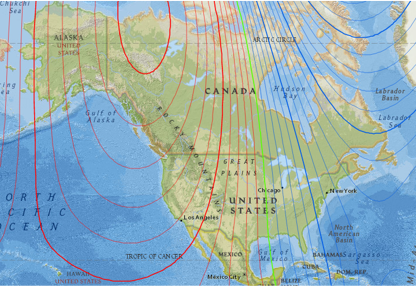 |
| Figure C-7 2021 Isogonic Lines |
The isogonic interval (difference between adjacent lines) is 2°00'; red lines are east declinations, blue are west. The green line is the agonic line.
Figure C-8 are isogonic lines across North America for 2000 across the same area.
 |
| Figure C-8 2000 Isogonic Lines |
The general pattern is similar to the map in Figure C-7 but there are differences. Note the agonic line change across the US.
The US Public Land Survey started in the 1780's. Figure C-9 shows the declinations in 1785.
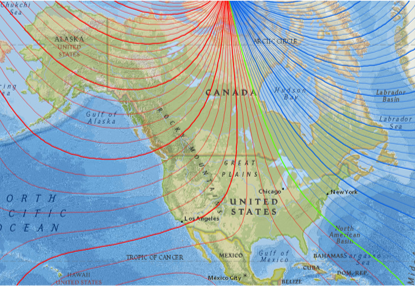 |
| Figure C-9 1785 Isogonic Lines |
Compare it to the 2000 and 2021 maps. Click here for a short video of declination change from the mid-1700s to 2021.
The maps in Figures C-7, -8, -9, and those in the video are from NOAA National Centers for Environmental Information (https://maps.ngdc.noaa.gov/viewers/historical_declination/).
c. Magnetic to True Examples
When converting between magneric and true directions, remember:
- The only thing that moves is the magnetic meridian. Even though a line's direction changes, it physically remains in its same position.
- Declination is specified for the north ends of the meridians, the magnetic south end of the meridian is off the same angle but in the opposite direction.
As simple as a meridian conversion is, the conversion is easy to apply incorrectly. A sketch helps tremendously.
Example 1
In 1885 the declination was 5°20'E
Sketch
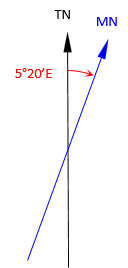
(a) The magnetic bearing of line AB in 1885 was recorded as N58º45’E. What is the true bearing of the line?
Sketches
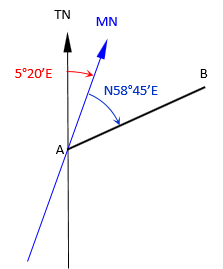 |
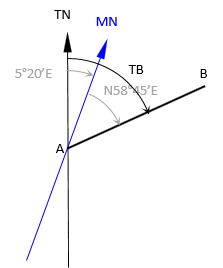 |
The true bearing angle is the sum of the magnetic bearing and deflection angles.

(b) The magnetic bearing of line AC in 1885 was recorded as S67º24’E. What is its true bearing?
Sketches
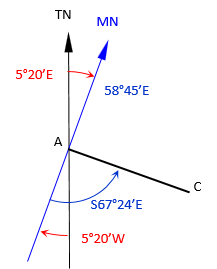 |
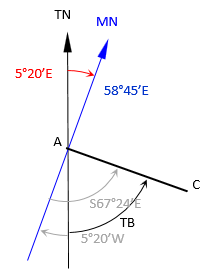 |
The true bearing angle is the difference between the bearing and deflection angles.

The declination angle is added to or subtracted from the bearing angle depending on the bearing quadrant.
Example 2
The magnetic bearing of line PQ in 1925 was recorded as S86º35’W. The present true bearing of the line is S79º50’W.
What was the declination in 1925?
Create a sketch in a series of steps
| Magnetic bearing of line PQ in 1925 was S86º35’W... | |
 |
|
| Present true bearing is S79°50'W... | |
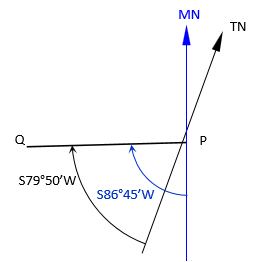 |
|
Come back from the line 79°50' to the east to establish the south end of the true meridian.
| What was the 1925 declination? | |
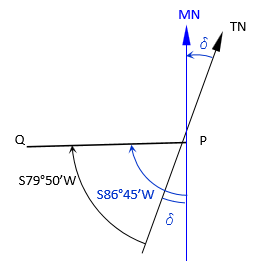 |
|
The declination is the difference between the two directions.
![]()
Since the north end of the magnetic meridian is west of the true meridian, the deflection is 6°55' W.
d. Surveyor's Compass
This section is not necessary for understanding delcination, but because a compass was an early angle measurement device, a brief description of it is included for some historical context.
When you look at the face of a traditional surveyor's compass, Figure C-10, you'll see that East and West are flipped. Huh, what's up with that?
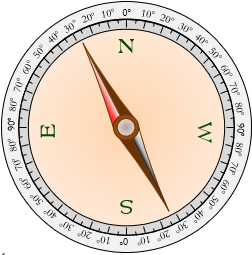 |
| Figure C-10 Surveyor's Compass |
Notable compass parts are, Figures C-11 and C-12:
- A - Sighting vanes (later replaced with a telescope)
- B - Magnetic needle
- C - Angle divisions
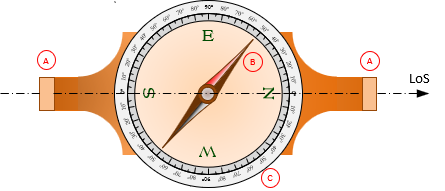 |
| Figure C-11 Surveyor's Compass - Top View |
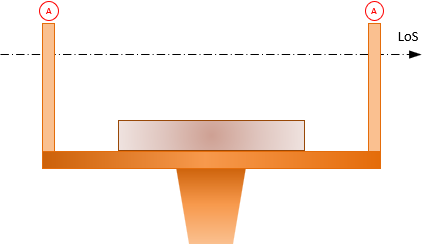 |
| Figure C-12 Surveyor's Compass - Side View |
Early compasses used a simple sighting system consisting of two upright vanes at the front and rear. A slit in each vane, aligned with the N and S compass marks, allowed the surveyor to sight on a point or target, Figure C-13.
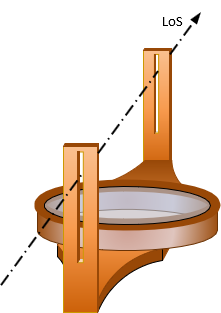 |
| Figure C-13 Surveyor's Compass - Perspective View |
Later instruments included first a fixed telescope, then one which rotated in a vertical plane. The compass lead to the transit which led to the theodolite which led to the total station... Most contemporary total stations include a tubular compass maintaining an evolutionary tie to the surveyor's compass.
The compass card is divided into four numbered quadrants. Each is numbered beginning with 0° at N and S, increasing to 90° at E and W, Figure C-14.
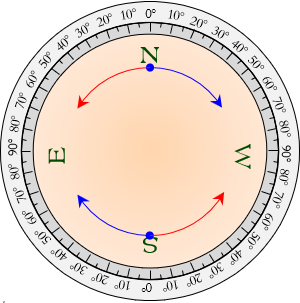 |
| Figure C-14 Compass Card |
The reversed east and west markings with the 0°-90° angle quadrants allow direct reading of a line's magnetic bearing.
The entire instrument is rotated to sight a point or target. The needle is free to swing, always pointing along the magnetic meridian, as the compass is rotated. When the aligned with the needle, Figure C-15, the LoS is either directly north or south.
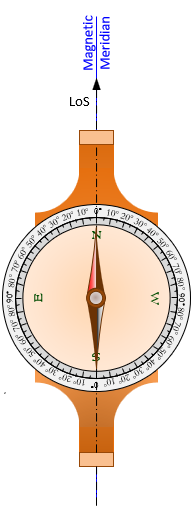 |
| Figure C-15 Sighting Along Meridian |
To determine the bearing to another point, the compass is rotated to sight it, Figure C-16.
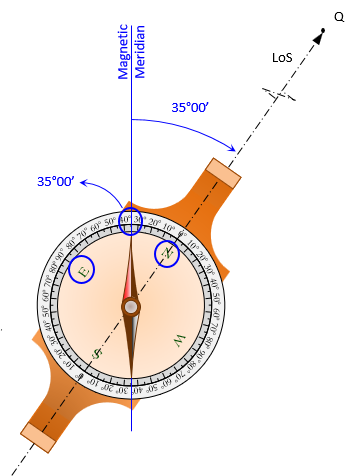 |
| Figure C-16 Magnetic Bearing to Point Q |
The north end of the needle is used to read the bearing angle and quadrant. The needle points at the bearing angle and its north end falls between the letters identifying the quadrant The magnetic bearing to point Q in Figure C-16 is N 35°00' E.
Sighting point R, Figure C-17,...
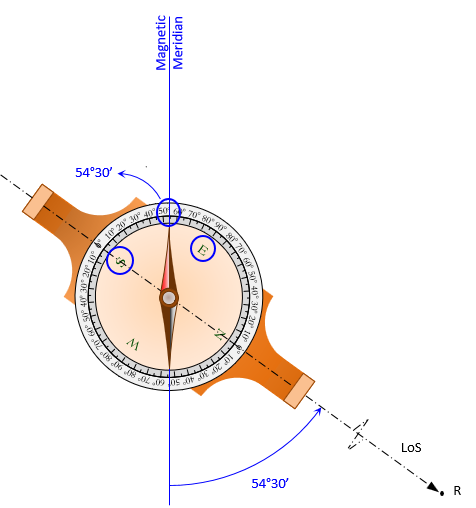 |
| Figure C-17 Magnetic Bearing to Point R |
... the magnetic bearing to it is is S 54°30' E. The north end of the needle is used to read the bearing.
By flipping East and West on the compass, bearings can be read directly without having to do any math. Neat, huh?